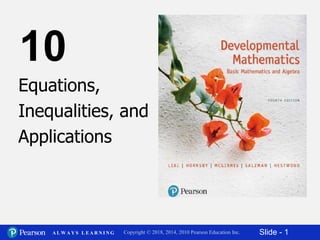
10.5 formulas and applications from geometry
- 1. Slide - 1Copyright © 2018, 2014, 2010 Pearson Education Inc.A L W A Y S L E A R N I N G 2 Equations, Inequalities, and Applications 10
- 2. Slide - 2Copyright © 2018, 2014, 2010 Pearson Education Inc.A L W A Y S L E A R N I N G 1. Solve a formula for one variable, given the values of the other variables. 2. Use a formula to solve an applied problem. 3. Solve problems involving vertical angles and straight angles. 4. Solve a formula for a specified variable. Objectives 10.5 Formulas and Additional Applications from Geometry
- 3. Slide - 3Copyright © 2018, 2014, 2010 Pearson Education Inc.A L W A Y S L E A R N I N G 36 = 2W P = 2L + 2W Check: 2 · 8 + 2 · 18 = 52 Solve a Formula for One Variable 2 18 = W Example Find the value of the remaining variable. P = 2L + 2W; P = 52; L = 8 52 = 2 · 8 + 2W 52 = 16 + 2W –16 –16 16 + 36 = 52 52 = 52 2
- 4. Slide - 4Copyright © 2018, 2014, 2010 Pearson Education Inc.A L W A Y S L E A R N I N G AREA FORMULAS Triangle A = ½bh Rectangle A = LW Trapezoid A = ½h(b + B) b = base h = height b h L = Length W = Width L W h = height b = small base B = large base b B h Solve a Formula for One Variable
- 5. Slide - 5Copyright © 2018, 2014, 2010 Pearson Education Inc.A L W A Y S L E A R N I N G Example The area of a rectangular garden is 187 in2 with a width of 17 in. What is the length of the garden? A = LW Check: 17 · 11 = 187 Use a Formula to Solve an Applied Problem 187 = L · 17 17 11 = L The length is 11 in. 17 17 L
- 6. Slide - 6Copyright © 2018, 2014, 2010 Pearson Education Inc.A L W A Y S L E A R N I N G 63 = 9h 9 Example Bob is working on a sketch for a new underwater vehicle (UV), shown below. In his sketch, the bottom of the UV is 10 ft long, the top is 8 ft long, and the area is 63 ft2. What is the height of his UV? A = ½h(b + B) Check: ½ · 7 · 18 = 63 Use a Formula to Solve an Applied Problem 63 = ½h(8 + 10) 7 = h 63 = ½h(18) The height of the UV is 7ft. 10 8 h 9
- 7. Slide - 7Copyright © 2018, 2014, 2010 Pearson Education Inc.A L W A Y S L E A R N I N G 2 3 1 The figure shows two intersecting lines forming angles that are numbered: , , , and . Solve Problems Involving Vertical and Straight Angles 32 4 Angles 1 and 3 lie “opposite” each other. They are called vertical angles. Another pair of vertical angles is 2 and 4.. Vertical angles have equal measures. Now look at angles 1 and 2. When their measures are added, we get the measure of a straight angle, which is 180°. There are three other such pairs of angles: 2 and 3, 3 and 4 and 4 and 1. 1 4
- 8. Slide - 8Copyright © 2018, 2014, 2010 Pearson Education Inc.A L W A Y S L E A R N I N G –4 = 2x – 40 3x – 4 = 5x – 40 Check: 5 · 18 – 40 = 50°2 18 = x Example Find the measure of each marked angle below. –3x –3x 2 Solve Problems Involving Vertical and Straight Angles (3x – 4)° (5x – 40)° Since the marked angles are vertical angles, they have equal measures. + 40 + 40 36 = 2x Thus, both angles are 3 · 18 – 4 = 50° CAUTION Here, the answer was not the value of x!
- 9. Slide - 9Copyright © 2018, 2014, 2010 Pearson Education Inc.A L W A Y S L E A R N I N G (x + 15)° 6 · 25 – 10 = 140° and 25 + 15 = 40° 7x + 5 = 180 6x – 10 + x + 15 = 180 Check: 140° + 40° = 180° 7 x = 25 Example Find the measure of each marked angle below. – 5 – 5 7 Solve Problems Involving Vertical and Straight Angles (6x – 10)° Since the marked angles are straight angles, their sum will be 180°. 7x = 175 Thus, the angles are
- 10. Slide - 10Copyright © 2018, 2014, 2010 Pearson Education Inc.A L W A Y S L E A R N I N G h Example Solve A = ½bh for b. A = ½bh Solve a Formula for a Specified Variable 2A = bh h The goal is to get b alone on one side of the equation. 2 · · 2 2A = b h